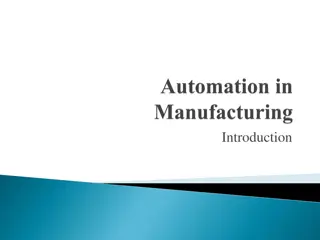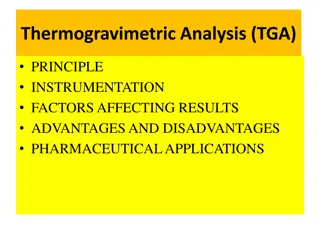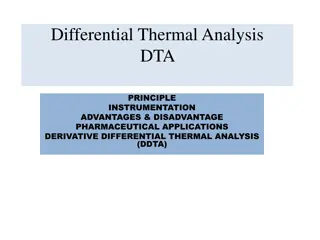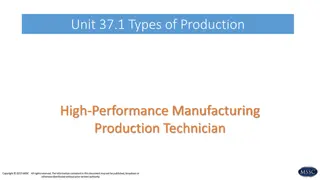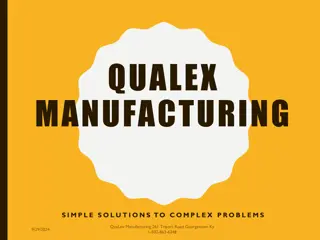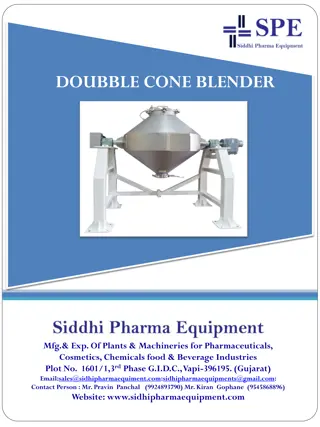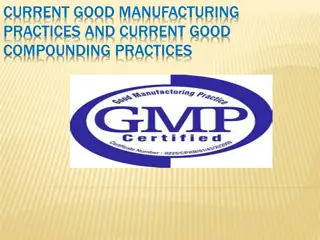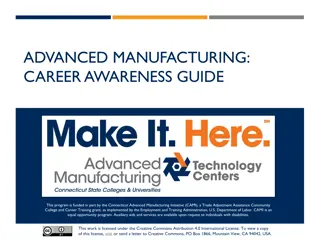Understanding cGMP Regulations in Pharmaceutical Manufacturing
cGMP regulations are essential standards set by the FDA to ensure high-quality drug products in the U.S. This content discusses the significance of cGMP in pharmaceutical manufacturing, common terms used, and the importance of adherence to these regulations for product quality and safety.
Download Presentation

Please find below an Image/Link to download the presentation.
The content on the website is provided AS IS for your information and personal use only. It may not be sold, licensed, or shared on other websites without obtaining consent from the author. Download presentation by click this link. If you encounter any issues during the download, it is possible that the publisher has removed the file from their server.
E N D
Presentation Transcript
Dosage Form Design Lecture 5 and 6 Dr. Athmar Dhahir Habeeb PhD in Industrial pharmacy and drug delivery athmar1978@uomustansiriyah.edu.iq athmar1978@yahoo.com athmar.habeeb.12@ucl.ac.uk
Current Good Manufacturing Practices cGMP Current Good Compounding Practices cGCP
cGMP are regulations established by FDA to Ensure that minimum standards are present for drug product quality in the US. They apply to domestic and foreign suppliers and manufacturers whose finished pharmaceutical products are imported, distributed or sold in the US bulk components and c GMP REGULATIONS include the followings :-
cGMP for finished pharmaceuticals Common terms used in these regulations are defined as Active pharmaceutical ingredient (API): Any component have pharmacologic activity in diagnosis, cure, mitigation, treatment or prevention of disease. Batch: A specific quantity of a drug of uniform specified quality produced according to single manufacturing order during the same cycle of manufacture. Certification: Documented testimony by qualified authorities that a system qualification, calibration, validation, or revalidation has been performed aproperiatly and that the results are acceptable. Compliance: manufacturer acting with prescribed regulations, standards, and practices.
Component: Any ingredient used in manufacture of drug product. Drug product: Finished form that contains active drug and inactive ingredients. Drug product: Finished form that contains active drug and inactive ingredients. Inactive ingredient: Any component other than the active ingredients in drug product. Lot: A batch or any portion of a batch having uniform specified quality and a distinctive identifying lot number. Lot number, control number, or batch number: combination of letters, numbers, or symbols from which the complete history of manufacture, processing, packaging, holding, and distribution of a batch or lot of a drug product may be determined.
Master record: Record containing the formulation, specifications, manufacturing assurance requirements, and labeling of finished product. procedures, quality Quality assurance: all evidence needed that activities relating to quality are being performed adequately. Quality control: process through which industry measures actual quality performance, compares it with standards. Quality control unit: organizational element designated by a firm to be responsible for work related to quality control. Quarantine: An area that is marked, designated, or set aside for the holding of incoming components prior to acceptance testing and qualification for use.
Representative sample: A sample that represent the whole product. Reprocessing recycling:The activity that finished product or any of its components is recycled through all or part of the manufacturing process. Strength: concentration of drug per unit dose or volume. Verified: Signed by a second individual or recorded by automated equipment. Validation: Documented evidence that a system (e.g., equipment, software, controls) does what it purpots to do. Process validation: Documented evidence that a process (e.g., sterilization) does what it purports to do. protocol: experimental documented evidence that the system has been validated. plan to produce Validation
Organization and personnel deals with responsibilities of quality control unit, employees, and consultants. The regulations require that a quality control unit have responsibility for all functions that may affect product quality. This includes accepting or rejecting product components, product specifications, finished products, packaging, and labeling. All personnel engaged in the manufacture, processing, packing, or holding of a drug product, including those in supervisory positions, are required to have the education, training, and/or experience needed to fulfill the assigned responsibility. Adequate laboratory facilities shall be provided, written procedures followed, and all records maintained. Appropriate programs of education and training, and performance evaluations are essential for maintaining quality assurance.
head of production department has generally the following responsibilities:- a) to ensure that products are manufactured and stored according to the appropriate documentation; b) to ensure that the necessary training of production personnel is carried out and adapted; c) to approve the instructions relating to production operations and to ensure their strict implementation; d) to ensure that the production records are evaluated and signed by a designated person . e) To check the maintenance of his department, premises, and equipment; f) to ensure that the appropriate validation and calibration of control equipment is performed and recorded.
head of the quality control department generally has the following responsibilities:- a) to approve specifications, sampling instructions, test methods, and other procedures ; b) to ensure that all necessary testing is carried out; c) to approve or reject, starting materials, packaging materials, and intermediate, bulk and finished products; d) to evaluate batch records. e) to approve and monitor analyses carried out under contract; f) to check the maintenance of the department, premises and equipment; g) to ensure that appropriate validations, including those of analytical procedures, and calibration of control equipment are done; h) to ensure that the necessary training of quality control personnel is carried out and adapted.
EQUIPMENT Each piece of equipment must be :appropriate design and size to facilitate use, cleaning, and maintenance. equipment's surfaces and parts must not interact with processes or product s so not affect purity, strength, or quality. Standard operating procedures must be written and followed for proper use, maintenance, and cleaning of each piece of equipment. equipment and computers used in the processes must be routinely calibrated, maintained, and validated for accuracy. Filters used in the manufacture or processing of injectable drug products must not release fibers into such products.
* Equipment should be installed in such a way as to minimize any risk of error or of contamination. * Equipment should be kept or stored in a clean condition and be checked for cleanliness prior to each use. * Defective equipment, if possible, should be removed from production and quality control areas, or labeled as defective. * Equipment used for weighing, measuring, testing and re-cording should be subject to regular recorded checks for accuracy and working order * Fixed pipe work (and valves) should be clearly labeled to indicate the contents, and the direction of flow. *Washing and cleaning equipment should be chosen and used in order not to be a source of contamination.
Control of components, containers and closure Written procedures, identification, storage, handling, sampling, testing, and approval or rejection of all product components, containers, and closures must be maintained and followed. Bulk pharmaceutical chemicals, containers, and closures must meet the exact physical and chemical specifications established with the supplier at the time of ordering Raw materials are quarantined until they are verified through representative sampling and careful qualitative and quantitative analysis. The quality control unit approves and releases for use in manufacture only those that meet the specifications Rejected components, containers, and closures are identified and controlled under a quarantine system to prevent their use in manufacturing and processing operations. As the majority of bulk chemicals (APIs) are synthesized in China and India, it is important to confirm their identity and purity with USP and NF prior to use in finished pharmaceuticals.
PRODUCTION AND PROCESS CONTROLS Written procedures are required to ensure that drug products have correct identity, strength, quality, and purity. In-process samples taken from production batches periodically for product control. In-process controls are of two general types: (a) those performed by production personnel at the time of operation to ensure that the machinery is producing output within preestablished control limits (e.g., tablet size, hardness) (b) those performed by the quality control laboratory personnel to ensure compliance with all product specifications (e.g., tablet content, dissolution) and batch- to-batch consistency.
Packaging and labeling control Written procedures are required for the receipt, identification, storage, handling, sampling, and testing of drug product and issuance of labeling and packaging materials. Labeling for each variation in drug product strength, dosage form, or quantity of contents must be stored separately with suitable identification. outdated labels and other packaging materials must be destroyed. Access to the storage area must be limited to authorized personnel. Each label must contain expiration dating and the production batch or lot number to facilitate product identification. Special packaging requirements may apply in certain instances, as with tamper-evident packaging for over-the-counter (OTC) products Expiration Dating To ensure that a drug product meets standards of identity, strength, quality, and purity at time of use. Except from this requirement are homeopathic drug products, allergenic extracts, and investigational drugs that meet the standards established during preclinical and clinical studies.
Tamper-Evident Packaging It is defined as one having one or more indicators or barriers to entry which, if breached or missing, can reasonably be expected to provide visible evidence to consumers that tampering has occurred. Today, the cGMP regulations require tamper-evident packaging for OTC drug products to improve their security and to assure their safety and effectiveness.
HOLDING AND DISTRIBUTION Written procedures must be established and followed for the holding and distribution of product. Finished pharmaceuticals must be quarantined in storage until released by the quality control unit. Products must be stored and shipped under conditions that do not affect product quality. the oldest approved stock is distributed first. The distribution control system must allow the distribution point of each lot of drug product to be readily determined to facilitate its recall if necessary.
LABORATORY CONTROLS Laboratory controls are requirements for the establishment of and conformance to : written specifications, standards, sampling plans, test procedures and other such mechanisms. The specifications, which apply to each batch of drug product, include sample size, test intervals, sample storage and stability testing special testing requirements for parenterals, ophthalmics , controlled- release products, and radioactive pharmaceuticals. * Reserve samples must be maintained for 1 to 3 years after the expiration date of the last lot of the drug product.
RECORDS AND REPORTS Production, control, and distribution records must be maintained for at least a year following the expiration date of a product batch. includes equipment cleaning specifications and lot numbers of product components, including raw materials and product containers and closures; and label records. This and maintenance logs; These master records must document that each step in the production, control, packaging, labeling, and distribution of the product was accomplished and approved by the quality control unit. Depending on the operation, the operator's and/or supervisor's full signatures, or other written or electronic identification codes are required.
Complete master production and control records for each batch must be kept and include the following: Name and strength of the product Dosage form Quantitative amounts of components. Complete manufacturing and control procedures Equipment used In-process controls Sampling and laboratory methods and assay results Calibration of instruments Distribution records Dated and employee-identified records All records must be made available at the time of inspection by FDA officials.
RETURNED AND SALVAGED DRUG PRODUCTS Returned drug products (e.g., from wholesalers) must be identified by lot number and product quality determined through appropriate testing. ((Drug products that meet specifications)) may be salvaged or reprocessed. ((Those that do not, along with those that have been subjected to improper storage (e.g., extremes in temperature), shall not be returned to the marketplace.
ADDITIONAL cGMP REQUIREMENTS Active Pharmaceutical Ingredients and Excipients the quality of any finished pharmaceutical product depends on the quality of the various components, including the active ingredients and pharmaceutical excipients, as they, too, are components of finished pharmaceutical products, must be produced in accordance with cGMP standards compliance with cGMPs is a critical part of the FDA's preapproval inspection program for new drug applications (NDAs) and abbreviated new drug applications (ANDAs). GMP focuses on all elements of chemical purity and quality, including following: Specifications and analytical methods for all reactive and nonreactive components used. Critical chemical reaction steps Handling of chemical intermediates Effect of scale-up of chemical batches on the yield Quality of water used. Solvent handling and recovery systems Analytical methods to detect impurities or chemical residues and limits set Stability studies of bulk pharmaceutical chemical 1. 2. 3. 4. 5. 6. 7. 8.
CLINICAL TRIAL MATERIALS CTM *The CTMs used in clinical investigations must be produced in compliance with the cGMP regulatory requirements and standardized as to identity, purity, strength, and quality . *However, during preclinical testing and the early phases of clinical evaluation, a product's formulation and many of the production processes and analytical controls are under development. Thus, during this period, the regulatory requirements are applied with flexibility. *As the clinical trials progress from Phase 1 to Phase 2, the processes are being characterized and refined, and during Phase 3 they are expected to meet all regulatory requirements. It is during Phase 3 that process optimization is demonstrated to the FDA by the production of at least one tenth of a commercial size batch (e.g., 100,000 capsules) of the proposed product.
BIOLOGICS cGMP standards are defined for biologic products in the Code of Federal Regulations .While the basic regulations for finished pharmaceuticals apply to biologic products as well, the nature of blood, bacterial, and viral products requires specific additional mandates. blood collection procedures; 1. environmental controls; 2. cell bank and cell line characterization and testing; 3. cell propagation and fermentation; 4. inactivation of infectious agents; 5. aseptic processing validation ; 6. live vaccine work areas; 7. work with spore-bearing organisms; 8. evaluation, quantification and validation of risk factors. 9.
MEDICAL DEVICES devices are approved for marketing when shown to be safe and effective through premarket approval. Medical devices are subject to the reporting of adverse events, to recall, and to termination of approval. The regulations for good manufacturing practice for medical devices are similar to those for finished pharmaceuticals. They include personnel; buildings; equipment; control of components; production and process controls; packaging and labeling; holding, distribution, and installation; device evaluation; and records. 1. 2. 3.
Devices covered by cGMP regulations include: intraocular lenses, hearing aids, 3. intrauterine devices, 4. cardiac pacemakers, clinical chemistry analyzers, 6. catheters, 7. cardiopulmonary bypass heart-lung machine console, dental X-ray equipment, 9. surgical gloves, 10. prosthetic hip joints, 11. traction equipment, 12. computed tomography equipment, and 13. powered wheelchairs. 1. 2. 5. 8.
cGMP REQUIREMENTS FOR MANUFACTURING IN PHARMACIES Pharmacies that engage in such activities must register with the FDA as a manufacturer or distributor and be subject to FDA inspection at regular intervals. Included are hospital pharmacies that repackage drug products for their own use and for the use of other hospitals; chain pharmacy operations that repackage and relabel bulk quantities of products for distribution in the chain; and similar repackaging and relabeling by individual pharmacists or pharmacies for distribution to other pharmacies or retailers. *Recently, professional attention has been directed toward differentiating between pharmaceutical manufacturing and compounding as practiced by community pharmacists . Pharmaceutical manufacturing is ((large-scale production of drugs or drug products for distribution and sale)), whereas compounding is ((professional preparation of prescriptions for specific patients as a part of the traditional practice of pharmacy)).
cGCP Current Good Compounding Practices A number of reasons have been presented for the increase in preparing patient- specific medications, including the following: 1. Many patients need drug dosages or strengths that are not commercially available. 2. Many patients need dosage forms are not commercially available. 3. Many patients are allergic to excipients in commercially available products. 4. Children's medications must be prepared as liquids, flavored to enhance compliance. 5. Some medications are not very stable and require preparation and dispensing every few days. 6. Many physicians desire to deliver products in innovative ways, and pharmacists can work with them to solve medication problems. 7. Most products are not available for veterinary patients and must be compounded. 8. Home health care and the treatment of an increasing number of patients at home have resulted in many community pharmacies and home health care pharmacies preparing sterile products for home use. 9. Hospice care has resulted in new approaches to pain management and higher concentrations and combinations of drugs that are now used. 10. Many drugs are reported in the literature but are not yet manufactured, so pharmacists can compound them for their physicians and patients use.
U.S. PHARMACOPEIA-NATIONAL FORMULARY In 2000, the U.S. Pharmacopeial Convention formed two compounding expert committees; one in nonsterile compounding and one in sterile compounding. The Expert Committee on Sterile Compounding prepared the USP Pharmaceutical Compounding-sterile Preparations which first became official in 2004 . Additional chapters in the USP related to compounding include Good Compounding Practices, Quality Assurance in Pharmaceutical Compounding, and Pharmaceutical Calculations in Prescription Compounding.
Packaging, Labeling, and Storage of Pharmaceuticals The proper packaging, labeling, and storage of pharmaceutical products are all essential for product stability and efficacious use. Containers When submitting an NDA, the manufacturer must include all relevant specifications for packaging the product. During the initial stages of clinical investigations, the packaging must be shown to provide adequate drug stability for the duration of the clinical trials. As the clinical trials advance to their final stage, information on the chemical and physical characteristics of the container, closure, and other component parts of the package system for the proposed product must be developed to ensure drug stability for its anticipated shelf life. According to the USP, a container is that which holds the article and is or may be in direct contact with the article. The immediate container is that which is in direct contact with the article at all times. The closure is part of the container. The container, should be clean and dry before it is filled with drug. must not interact physically or chemically with the drug. Ex: sorption of diazepam, to low density plastics resulting in a loss of drug avoided with the use of glass containers.
Different specifications are required for parenteral, nonparenteral, pressurized, and bulk containers and for those made of glass, plastic, and metal. In each instance, the package and closure system must be shown to be effective for the particular product for which it is intended. Depending on the intended use and type of container, among the qualities tested are the following: Physicochemical properties Light transmission for glass or plastic Drug compatibility Leaching and/or migration Vapor transmission for plastics Moisture barrier Toxicity for plastics Valve, actuator, metered dose, particle size, spray characteristics, and leaks for aerosols Sterility and permeation for parenteral containers Drug stability for all packaging
The USP classifies containers according to their ability to protect their contents from external conditions. container. protects contents from well-closed extraneous solids and from loss under ordinary conditions of handling, shipment, storage, and distribution. A tight container protects contents from contamination by extraneous liquids, solids, or vapors, or evaporation under the ordinary conditions of handling, shipment, storage, and distribution and is capable of tight reclosure. A hermetic container is impervious to air or any other gas under the ordinary conditions of handling, shipment, storage, and distribution. Sterile hermetic containers hold preparations intended for injection or parenteral administration. 1. 2. 3. 4.
5- A single-dose container :is one that holds a quantity of drug intended as a single dose and when opened, cannot be resealed with assurance that sterility has been maintained. These containers include fusion sealed ampoules and prefilled syringes and cartridges. 6- A multiple-dose container is a hermetic container that permits withdrawal of successive portions of the contents without changing the strength or affect the quality or purity of the remaining portion. These containers are commonly called vials.
Dosage forms, such as tablets, capsules, and oral liquids, may be packaged in single unit or multiple-unit containers Single unit or unit dose package: Advantages includes positive identification of each dosage unit and reduction of errors, reduced contamination of the drug. The packaging materials may be combinations of paper, foil, plastic, or cellophane. The packaging of solid dosage forms in clear plastic or aluminum blister wells is perhaps the most popular method of single-unit packaging Oral liquids May be dispensed in single units in paper, plastic, or foil cups or prepackaged and dispensed in glass containers having threaded caps or crimped aluminum caps. A number of hospital pharmacies package oral liquids for children s use in disposable plastic oral syringes with rubber or plastic tips on the orifice for closure
Other dosage forms, such as suppositories, powders, ointments, creams, and ophthalmic solutions, are also commonly found in single-unit packages provided by their manufacturers. unit-of-use packaging the quantity of drug product prescribed is packaged in a container. Ex: if certain antibiotic capsules are prescribed to be taken 4 times a day for 10 days, unit-of-use packaging would contain 40 capsules. Other products may be packaged to contain a month's supply. light-resistant containers A container made of amber glass or a light-resistant opaque plastic will reduce light transmission sufficiently to protect a light-sensitive pharmaceutical. ultraviolet absorbers may be added to plastic to decrease the transmission of short ultraviolet rays. USP standards that define the acceptable limits of light transmission at any wavelength between 290 and 450 nm.
recent innovation in plastic packaging is the coextruded two-layer high-density polyethylene bottle, which has an inner layer of black polyethylene coextruded with an outer layer of white polyethylene. Increasingly being used in packaging of tablets and capsules. The container provides: (light resistance and moisture protection. Glass used in packaging pharmaceuticals 4 categories depending on the chemical constitution of the glass and its ability to resist deterioration : Types I, II, and III intended for parenteral products, and type NP is intended for other products. Each type tested according to resistance to water attack. Degree of attack is determined by amount of alkali released from glass in specified test conditions. Leaching of alkali from glass to preparation could alter pH 1. Stability of product. 2. Type I is most resistant glass of 4 categories.
Today, most products are packaged in plastic. intravenous fluids, plastic ointment tubes, plastic film- protected suppositories, and plastic tablet and capsule vial. Advantage of plastics over glass: 1. Light and resistance to impact, which reduces costs and losses due to container damage 2. Versatility in container design, consumer acceptance 3. Consumer preference for plastic squeeze bottles in administration of ophthalmic, nasal sprays, and lotions 4. The popularity of blister packaging and unit-dose dispensing. The term plastic does not apply to a single type of material but rather to a vast number of materials, each developed to have desired features
Example, Addition of methyl groups to every other carbon atom in the polymer chains of polyethylene will give polypropylene, material that can be autoclaved. If a chlorine atom is added to every other carbon in the polyethylene polymer, polyvinyl chloride (PVC) is produced. This material is rigid and has good clarity, making it particularly useful in the blister packaging of tablets and capsules. However, it has a significant drawback for packaging medical devices (e.g., syringes): it is unsuitable for gamma sterilization, a method that is being used increasingly. The placement of other functional groups on the main chain of polyethylene or added to polymers can give a variety of alterations to final plastic material. Among the newer plastics are polyethylene terephthalate (PET), amorphous polyethylene terephthalate glycol (APET), and polyethylene terephthalate glycol (PETG). Both APET and PETG have excellent transparency and can be sterilized with gamma radiation.
Among problems encountered in the use of plastics in packaging are: (a) Permeability of containers to atmospheric oxygen and moisture vapor. (b) Leaching of constituents of to the internal contents. (c) Absorption of drugs from contents to container. (d) transmission of light through container. (e) Alteration of container upon storage. Agents added to alter the properties of plastics includes plasticizers, stabilizers, antioxidants, antistatic agents, antifungal agents, colorants, and others. The permeability of a plastic is a function of: Nature of polymer; 1. the amounts and types of plasticizers, fillers, lubricants, pigments and other additives; 2. pressure; and temperature. 3. Increases in temperature, pressure, and the use of additives tend to increase permeability of plastic. Glass containers are less permeable than plastic containers
Many products liable to deteriorate in humidity unless protected by high-barrier packaging. Desiccant silica gel in small packets, commonly included as protection against effects of moisture vapor. Drug substances that are subject to oxidative degradation may undergo a greater degree of degradation when packaged in plastic than in glass. Liquid in plastic may lose drug molecules or solvent to the container, altering the concentration of drug in product and affecting its potency. Leaching is term used to describe movement of components of container to contents. Compounds leached: polymer additives, such as the plasticizers, stabilizers, or antioxidants. The leaching occurs when liquids or semisolids are packaged in plastic. Little leaching occurs when tablets or capsules are packaged in plastic. influenced by temperature, agitation
Sorption indicate binding of molecules to polymer (both adsorption and absorption). Sorption occurs through chemical or physical means. un-ionized species of solute has greater tendency to bound than ionized species. Degree of ionization of a solute affected by pH of solution, the pH may influence sorption of particular solute. Plastic materials with polar groups are prone to sorption. Because sorption depends on penetration or diffusion of a solute into plastic. Sorption may occur with active pharmacologic agents or with excipients. Sorption may be initiated by the adsorption of a solute to the inner surface of a plastic container. After saturation of the surface, the solute may diffuse into the container and bound within plastic. The sorption of excipients :colorants, preservatives, or stabilizers would likewise alter the quality of product. Methylparaben may be sorbed to some types of plastics, resulting in a decrease in the available concentration of preservative.
Deformations, softening, hardening, and other physical changes in plastic containers can be caused by the action of container's contents or external factors, including changes in temperature and physical stress placed upon the container in handling and shipping. Child-Resistant & Adult-Senior use Packaging Defined as one that is significantly difficult for children under 5 years of age to open or to obtain a harmful amount of its contents within a reasonable time and that is not difficult for normal adults to use properly. At present, all legend drugs intended for oral use must be dispensed by the pharmacist to the patient in a container having a child-resistant closure unless the prescriber or the patient specifically requests otherwise or unless the product is specifically exempt from the requirement.
Compliance packaging To assist patients in taking their medications on schedule, manufacturers and pharmacists have devised numerous educational techniques, reminder aids, compliance packages, blister packaging in a calendar pack and devices. These medication compliance useful for patients taking multiple medications. *The many factors associated with noncompliance include ((misunderstanding the dosing schedule, confusion because the patient is taking multiple medications, forgetfulness, and a feeling of well-being leading to premature discontinuance of medication)) LABELING Different manufacturer's prescription drugs, controlled substances, dispensed prescription medication, OTC products, products for animals, medical devices, and other specific categories and specific products. In every instance, federal labeling requirements may be strengthened by state law. labeling requirements apply to investigational drugs,
MANUFACTURER'S LABEL The nonproprietary name of drug or The name of the manufacturer, packer, or distributor of the product. 1. A quantitative statement of the amount of each drug per unit of weight, volume, or dosage unit. 2. The pharmaceutical type of dosage form constituting the product 3. The net amount of drug product contained in the package, in units of weight, volume, or number of dosage units, as appropriate 4. 5. The logo Rx only or the federal legend Caution Federal law prohibits dispensing without prescription or a similar statement. 6. A label reference to refer to the accompanying package insert or other product literature for dosage and other information. 7. Special storage instructions when applicable. 8. The National Drug Code identification number for the product (and often a bar code) 9. An identifying lot or control number. 10. An expiration date. Warning May be habit forming may also appear.
PRESCRIPTION LABEL When dispensing a prescription, by federal law, the pharmacist must include the following information on the label of the dispensed medication: Name and address of the pharmacy Serial number of prescription Date of the prescription or the date of its filling or refilling (state law often determines which date is to be used). Name of prescriber Name of patient Directions for use, include any precautions, as indicated on prescription. 1. 2. 3. 4. 5. 6.
In addition, state laws may require additional information: The address of the patient The initials or name of the dispensing pharmacist The telephone number of the pharmacy The drug name, strength, and manufacturer's lot or control number The expiration date of the drug The name of the manufacturer or distributor In an effort to decrease medication errors, there is thought to include the indication on the prescription label to help the pharmacist assure the prescribed drug is appropriate. 1. 2. 3. 4. 5. 6. 7.
OVER-THE-COUNTER LABELING The FDA now requires a standardized format for the manufactures more than products. labeling 100,000 of OTC In addition to the name of the product, the address of the manufacturer or distributor, the quantity of net contents, the bar code and other product-identifying items, the expiration date, and the other drug-specific required information, following drug facts must appear in this listed order: name and the
The products active ingredients, including the amount in each dosage unit The purpose of the product The uses (indications) for the product Specific warnings, including when the product should not be used under any circumstances and when it is appropriate to consult with a doctor or pharmacist. This section also describes side effects that could occur and substances or activities to avoid. Dosage instructions when, how, and how often to take the product The product s inactive ingredients and important information to help consumers avoid ingredients that may cause an allergic reaction The format and design of the label are intended to be easily read and understood, particularly by seniors who purchase over 30% of the OTC pharmaceutical products sold in the United States.
Dietary Supplement Labeling The manufacturers of dietary supplements must follow the FDA s cGMP guidelines for dietary supplements, including labeling requirements and are permitted to make certain label claims. However, the claims must be accurate and truthful. This act disallows disease claims that infer or imply that the product can be used to prevent, treat, cure, mitigate, or diagnose a disease. Thus, structure/function claims are allowed on the label. An example would be a claim that a product helps improve mood rather than treat depression. Should write :This product is not intended to diagnose, treat, cure, or prevent any disease. For herbal products, the label must also state the part of the plant used to make the product, for example, root, stem, leaf. Must provide minimum information about the product prior to its use.



